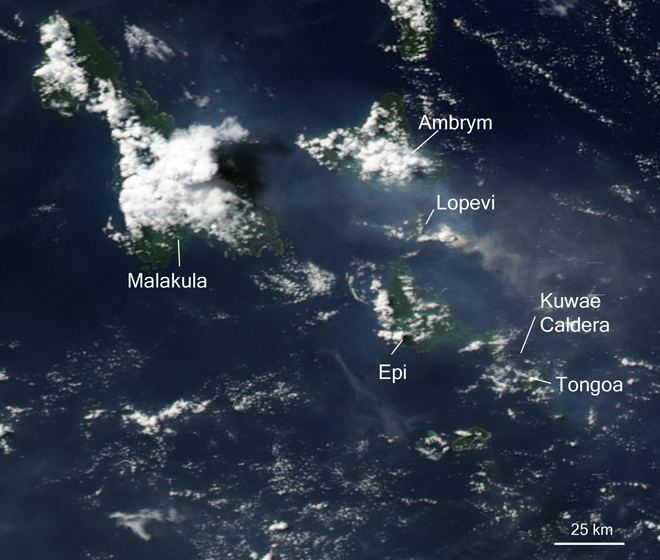Mountain type Caldera Last eruption September 1974 | ||
 | ||
Elevation –2 m (–6 ft)avg less than–400 m (–1,312 ft) Similar Lopevi, Nabukelevu, Metis Shoal, Zealandia Bank, Fonualei | ||
Kuwae is a submarine caldera between the Epi and Tongoa islands in Vanuatu. Kuwae Caldera cuts through the flank of the Tavani Ruru volcano on Epi and the northwestern end of Tongoa.
Contents
- Map of Kuwae Vanuatu
- Eruptive history
- Recent activity
- Climatic consequences of 14521453 event
- References
Map of Kuwae, Vanuatu
The submarine volcano Karua, one of the most active volcanoes of Vanuatu, is near the northern rim of Kuwae Caldera.
Eruptive history
Tongoa and Epi islands once formed part of a larger island called Kuwae. Local folklore tells of a cataclysmic eruption that split this island into two smaller islands with an oval 12 x 6 km caldera in between (but the story tells of an eruption south of Tongoa). Collapse associated with caldera formation may have been as much as 1100 m. Around 32–39 km³ of magma was erupted, making the Kuwae eruption one of the largest in the last 10,000 years.
In Antarctic and Greenland ice cores, a major eruption or series of eruptions is revealed as a spike in sulfate concentration, showing that the release in form of particles was higher than any other eruption since. Also, analysis of the ice cores pinpointed the event to late 1452 or early 1453. The volume of expelled matter is more than six times larger than that of the 1991 Pinatubo eruption and would have caused severe cooling of the entire planet the following three years. The link between the sulphur spike and the Kuwae caldera is questioned in a 2007 study by Károly Németh, et al. proposing the Tofua caldera as an alternative source candidate. Google Earth view of Tongoa and Epi
Recent activity
Since the eruption of c. 1452, Kuwae caldera has had several smaller eruptions with VEIs of 0 to 3. The latest confirmed eruption occurred on 4 February 1974 ± 4 days. It had a VEI of 0, and was a submarine eruption that formed a new island.
Islands have regularly formed in Kuwae caldera. The 1897–1901 eruption built an island 1 km long and 15 m high. It disappeared within 6 months. The 1948–1949 eruption formed an island and built a cone 1.6 km in diameter and 100 m high. That island also lasted less than one year. All the islands have disappeared from wave action and caldera floor movements. In 1959, the island reappeared for a short time and again in 1971. The last structure remained an island until 1975.
Activity at present at Kuwae is confined to intermittent fumarole activity, which stain the water yellow. Over the top of the volcano hydrogen sulfide bubbles reach the surface.
Climatic consequences of 1452–1453 event
The Kuwae eruption has been linked with the second pulse of the Little Ice Age, which had started two centuries earlier with a series of four unidentified eruptions.
A study by Dr Kevin Pang of the Jet Propulsion Laboratory drew on evidence found in tree rings, ice cores and in the historic records of civilizations in Europe and China. Oak panels of British portrait paintings had abnormally narrow rings in 1453–55.
In Sweden, grain tithes fell to zero as the crops failed; Western US bristlecone pines show frost damage in 1453; and the growth of European and Chinese trees was stunted in 1453–57.
According to the history of the Ming Dynasty in China in the spring of 1453, "Nonstop snow damaged wheat crops". Later that year, as the dust obscured the sunlight, "Several feet of snow fell in six provinces; tens of thousands of people froze to death".
Early in 1454, "it snowed for 40 days south of the Yangtze River and countless died of cold and famine". Lakes and rivers were frozen, and the Yellow Sea was icebound out to 20 km from shore.
The eruption occurred just before the Fall of Constantinople, the last bastion of the once-mighty Byzantine Empire. The Ottoman Turks, led by Sultan Mehmed II, laid siege to the city on 5 April 1453 and conquered it on 29 May 1453. Pang found mention of the volcano's after effects in chronicles of the city's last days. Historians noted the city's gardens, that spring, produced very little. On the night of 22 May 1453, the moon, the symbol of Constantinople, rose in dark eclipse, fulfilling a prophecy of the city's demise. On 25 May 1453, a thunderstorm burst on the city: "It was impossible to stand up against the hail, and the rain came down in such torrents that whole streets were flooded". The next day, on 26 May 1453, the whole city was blotted out by a thick fog, a condition that unknown in that part of the world in that month.
When the fog lifted that evening, "flames engulfed the dome of the Hagia Sophia, and lights, too, could be seen from the walls, glimmering in the distant countryside far behind the Turkish camp (to the west)", historians noted. Residents of the city thought the strange light was from reflection from a fire set by the Turkish attackers. Pang said, however, that the "fire" was an optical illusion by the reflection of intensely red twilight glow by clouds of volcanic ash high in the atmosphere. Many such false fire alarms were reported worldwide after the 1883 Krakatoa eruption in Indonesia.
Peng said, "I conclude that Kuwae erupted in early 1453.... The residual volcanic cloud could have made the apocalyptic June 1456 apparition of the Comet Halley look 'red' with a 'golden' tail, as reported by contemporary astronomers".
